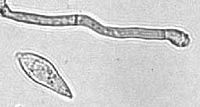
Photo from wikipedia
Magnaporthe grisea (T.T. Herbert) M.E. Barr is a major fungal phytopathogen that causes blast disease in cereals, resulting in economic losses worldwide. An in-depth understanding of the basis of virulence… Click to show full abstract
Magnaporthe grisea (T.T. Herbert) M.E. Barr is a major fungal phytopathogen that causes blast disease in cereals, resulting in economic losses worldwide. An in-depth understanding of the basis of virulence and ecological adaptation of M. grisea is vital for devising effective disease management strategies. Here, we aimed to determine the genomic basis of the pathogenicity and underlying biochemical pathways in Magnaporthe using the genome sequence of a pearl millet-infecting M. grisea PMg_Dl generated by dual NGS techniques, Illumina NextSeq 500 and PacBio RS II. The short and long nucleotide reads could be draft assembled in 341 contigs and showed a genome size of 47.89 Mb with the N50 value of 765.4 Kb. Magnaporthe grisea PMg_Dl showed an average nucleotide identity (ANI) of 86% and 98% with M. oryzae and Pyricularia pennisetigena, respectively. The gene-calling method revealed a total of 10,218 genes and 10,184 protein-coding sequences in the genome of PMg_Dl. InterProScan of predicted protein showed a distinct 3637 protein families and 695 superfamilies in the PMg_Dl genome. In silico virulence analysis revealed the presence of 51VFs and 539 CAZymes in the genome. The genomic regions for the biosynthesis of cellulolytic endo-glucanase and beta-glucosidase, as well as pectinolytic endo-polygalacturonase, pectin-esterase, and pectate-lyases (pectinolytic) were detected. Signaling pathways modulated by MAPK, PI3K-Akt, AMPK, and mTOR were also deciphered. Multicopy sequences suggestive of transposable elements such as Type LTR, LTR/Copia, LTR/Gypsy, DNA/TcMar-Fot1, and Type LINE were recorded. The genomic resource presented here will be of use in the development of molecular marker and diagnosis, population genetics, disease management, and molecular taxonomy, and also provide a genomic reference for ascomycetous genome investigations in the future.
Journal Title: Journal of Fungi
Year Published: 2022
Link to full text (if available)
Share on Social Media: Sign Up to like & get
recommendations!